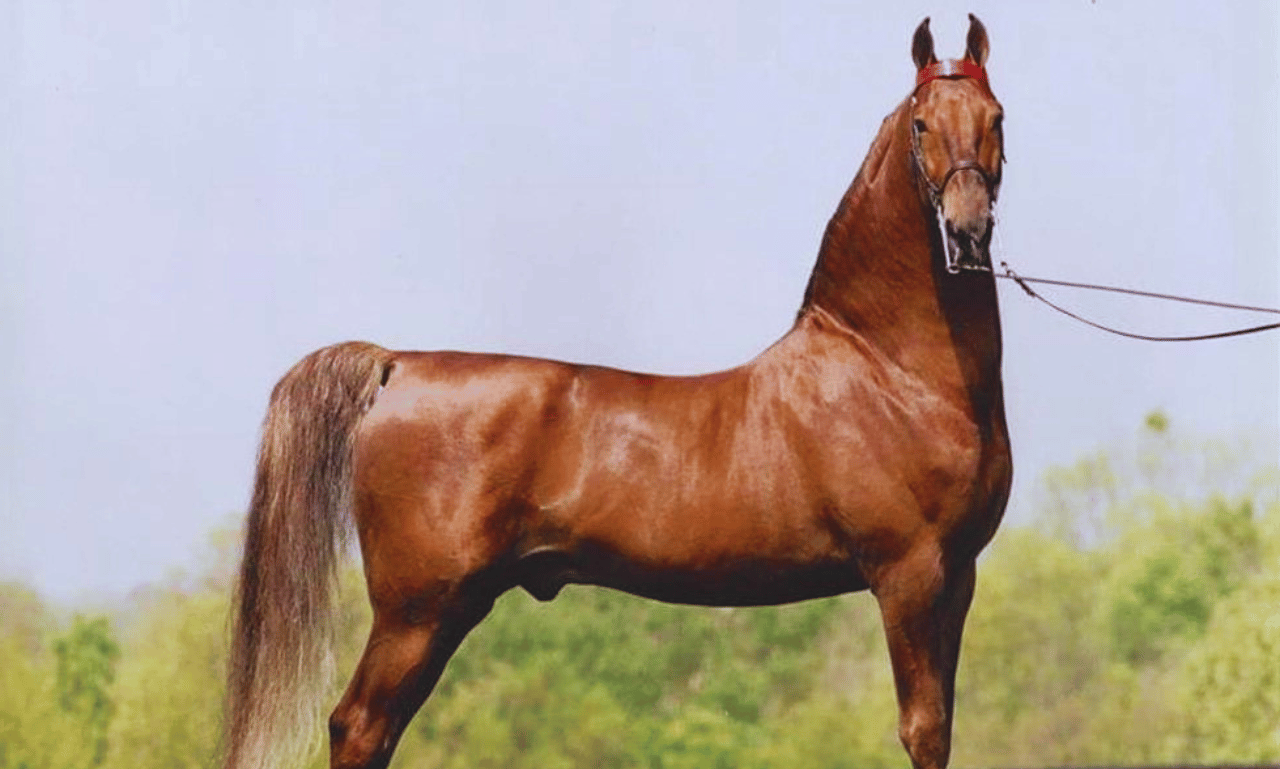The American Saddlebred, affectionately known as “the horse America made,” stands as one of the most distinctive and elegant horse breeds in the world. This breed combines athletic ability, striking beauty, and a willing temperament that has made it a favorite among equestrians for centuries .
Quick Facts
| Characteristic | Details |
|---|---|
| Height Range | 15-16 hands (152-163 cm) |
| Weight Range | 450-540 kg (1,000-1,200 lbs) |
| Color Variations | Bay, black, brown, chestnut, gray, roan, palomino, pinto |
| Common Markings | Various white markings |
| Temperament | Calm, friendly, intelligent, willing to learn |
| Primary Uses | Show riding, driving, pleasure riding |
| Life Expectancy | 25-30 years |
| Origin | United States (Kentucky) |
| Conservation Status | Stable |
Historical Development
The American Saddlebred’s story begins in the 1700s during the colonial period of the United States. American colonists developed the breed by crossing Thoroughbreds with the now-extinct Narragansett Pacer[8]. This initial crossing produced horses with improved stamina and enhanced gaited abilities[8].
The breed’s development took a significant turn when it reached Kentucky, where it earned its first name as the “Kentucky Saddler.” During this period, additional Thoroughbred, Morgan, and Canadian bloodlines were incorporated to enhance the breed’s characteristics. A pivotal moment in the breed’s history came with the designation of Denmark, born in 1839, as the Foundation Sire.
The American Saddlebred played a crucial role in American military history, serving as the mount of choice for many generals during both the Revolutionary War and the Civil War. Their comfortable gaits and exceptional endurance made them ideal military mounts.
In 1891, a significant milestone was reached with the establishment of the American Saddle Horse Breeders’ Association (now the American Saddlebred Horse Association), which became the first horse breed registry in the United States[8]. Since then, nearly 250,000 American Saddlebreds have been registered, and the breed has spread globally with separate registries in Great Britain, Australia, continental Europe, and southern Africa.
Physical Characteristics
| Feature | Description |
|---|---|
| Head | Well-shaped with large, luminous eyes set far apart |
| Neck | Long, slender, and well-arched |
| Body | Densely muscled with short, strong back |
| Legs | Flat and straight bones |
| Movement | High-stepping, animated action |
| Special Features | High-set, fluid tail carriage |
The American Saddlebred possesses a distinctive appearance characterized by its proud carriage and elegant structure. Their body features a rounder barrel than most light breeds, with well-sprung ribs and a deep, sloping shoulder. The breed’s prominent withers and well-defined conformation contribute to its naturally upright stance and impressive presence.
Temperament & Personality
The American Saddlebred is renowned for its people-oriented personality and exceptional character. These horses possess an intelligent, sensitive, and alert nature that makes them outstanding partners for riders[1]. Their natural confidence and willingness to work create strong bonds with their handlers, though their sensitivity may require experienced guidance for novice riders.
Performance & Uses Table
| Discipline | Suitability Rating | Notes |
|---|---|---|
| Saddle Seat | ★★★★★ | Excels in show ring with animated gaits |
| Driving | ★★★★☆ | Strong performer in fine harness |
| Dressage | ★★★☆☆ | Growing popularity in this discipline |
| Trail Riding | ★★★☆☆ | Suitable for pleasure riding |
| Eventing | ★★★☆☆ | Shows promise in combined events |
Distinctive Gaits
The American Saddlebred is unique in its gaiting abilities, with two distinct classifications:
Three-Gaited Saddlebreds perform the standard walk, trot, and canter with exceptional animation and fluidity[1].
Five-Gaited Saddlebreds can perform two additional ambling gaits:
- The slow gait: A four-beat gait with a distinctive hesitation
- The rack: A faster, smooth four-beat gait without suspension
Health & Management
American Saddlebreds require careful attention to their health and management due to several breed-specific considerations:
Common Health Concerns
- Musculoskeletal injuries from high-action movement
- Stifle and hock issues, particularly in performance horses
- Higher incidence of laminitis in inactive horses
- Genetic predisposition to lordosis (swayback)
Care Requirements
- Regular veterinary care: $250-350 annually for routine care
- Hoof care: $120-1,000 annually with trimming every 6-8 weeks
- Specialized nutrition program to support performance needs
- Strategic exercise program to maintain soundness
Breed Demographics & Cost Analysis
The American Saddlebred remains a popular breed in the United States, with costs varying significantly based on quality and training level.
Purchase Price Range
- Basic riding horses: $1,000-$10,000
- Show-quality horses: Up to $100,000
- Elite show horses: Can exceed $160,000[4]
Annual Care Costs
| Expense Category | Annual Cost Range |
|---|---|
| Board | $5,946-$9,324 |
| Feed & Supplements | $250-$4,380 |
| Basic Veterinary Care | $250-$350 |
| Farrier Services | $120-$1,000 |
| Training (optional) | Variable |
Modern Role & Competition
The American Saddlebred excels in multiple disciplines today:
Show Ring Specialties
- Three-gaited classes
- Five-gaited classes
- Fine harness competitions
- Saddle seat equitation
Other Uses
- Pleasure riding
- Trail riding
- Dressage
- Combined driving
- Hunter/jumper events
Special Care Considerations
American Saddlebreds require particular attention to:
Grooming Requirements
- Regular mane and tail conditioning
- Daily body grooming
- Special attention to long, flowing tails
- Preventive hoof care
Exercise Needs
- Regular controlled exercise
- Proper warm-up before high-action work
- Strategic training program to prevent strain
Breed Conservation & Future
The American Saddlebred continues to thrive through dedicated breeding programs and conservation efforts. The American Saddlebred Horse and Breeders Association (ASHBA), headquartered at the Kentucky Horse Park in Lexington, leads these initiatives.
Notable Achievements & Recognition
Show Ring Success
- World Championship Horse Show offers over $1 million in prize money
- Features over 2,000 horses competing annually
- Held at Kentucky State Fair since 1902
Famous Horses
- Wing Commander: First Saddlebred to win six World Grand Championships
- The Lemon Drop Kid: Featured on Sports Illustrated cover
- CHSky Watch and CHImperator: Legendary five-gaited rivals
Modern Breeding Programs
Focus Areas
- Show ring excellence
- Sport horse development
- Pleasure riding qualities
- Preservation of traditional bloodlines
Geographic Distribution
- Primary breeding center remains in Kentucky
- Growing international presence in:
- South Africa
- Australia
- United Kingdom
- Continental Europe
Future Outlook
The breed faces several challenges and opportunities:
Challenges
- Maintaining genetic diversity
- Adapting to changing market demands
- Preserving traditional characteristics
Opportunities
- Growing interest in versatility events
- Expansion into new disciplines
- International market development
The ASHBA continues to promote and protect the breed through:
- Recording pedigrees
- Supporting youth programs
- Educating the public
- Promoting safe equestrian activities
Final Sections & Ownership Guide
Buying Considerations
- Research reputable breeders and dealers
- Obtain veterinary pre-purchase examination
- Check registration papers and lineage
- Consider show record for competition prospects
- Evaluate temperament match with intended use
Where to Find Saddlebreds
- ASHBA registered breeders
- Professional training barns
- American Saddlebred Museum referrals
- Specialized equine sales
- Show barns and riding academies
Resources & Organizations
The American Saddlebred Horse and Breeders Association (ASHBA) serves as the primary registry and promotional organization for the breed. Located at the Kentucky Horse Park in Lexington, it offers:
- Breed registration services
- Show regulations and sanctions
- Educational programs
- Youth initiatives
- Professional development
Legacy & Impact
The American Saddlebred has left an indelible mark on American equestrian culture through:
- Pioneering American horse shows
- Establishing the first U.S. breed registry
- Contributing to military service
- Developing show ring excellence
- Advancing gaited horse preservation
Citations:
[1] https://www.petmd.com/horse/breeds/c_hr_american_saddlebred
[2] https://www.britannica.com/animal/American-Saddlebred-horse
[3] https://madbarn.com/american-saddlebred-horse-breed-profile/
[4] https://www.starstable.com/en/horses/breeds/american-saddlebred
[5] https://en.wikipedia.org/wiki/American_Saddlebred
[6] https://horsesonly.com/saddlebred-horse/
[7] https://www.thesprucepets.com/american-saddlebred-horse-breed-profile-4783512
[8] https://ker.com/equinews/history-american-saddlebred/
[9] https://www.fei.org/stories/lifestyle/health-fitness/breed-profile-american-saddlebred-horse
[10] https://www.savvyhorsewoman.com/2022/08/american-saddlebred.html
[11] https://www.usef.org/compete/breeds/american-saddlebred

